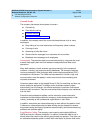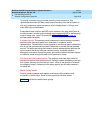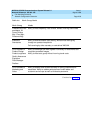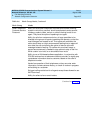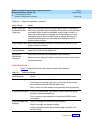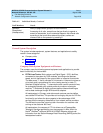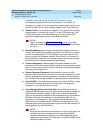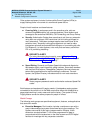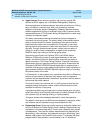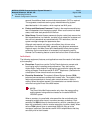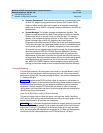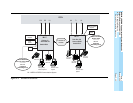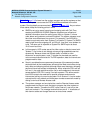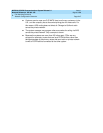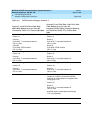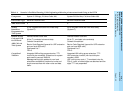
MERLIN LEGEND Communications System Release 6.1
Network Reference
555-661-150
Issue 1
August 1998
Call-Handling Scenarios
Page 2-42Network Configuration Scenarios
2
■ Agent Groups. When calls are routed by dial plan from outside PRI
facilities with ANI, agents use a LAN-based PassageWay Telephony
Services application to access customer information as calls arrive. Calling
party information is used as a key field in the company’s customer
database, and allows agents’ PassageWay Telephony Services worktop
software applications to bring up customer history files. Customer service
representatives use a CTI link power-dialing LAN application to reach large
numbers of customers rapidly.
Two delay announcement devices are attached to play messages for
customers calling both groups. The primary delay announcement device
plays an announcement for callers; a secondary delay announcement
reassures those callers who have waited for 30 seconds or more after
hearing the first announcement. Callers also hear Music On Hold while
they wait. During a delayed announcement, callers have the option of
dialing # in order to leave a message for an agent at the centralized
VMS/AA, rather than waiting in the calling group queue.
Supervisors have Direct-Line Consoles (DLCs) and Direct Station
Selectors (DSSs) with a button for each agent extension on the local
system, and with the Extension Status feature to monitor the status of
agents’ extensions. The Group Calling Overflow Threshold Time setting
signals when too many callers are waiting in the queue. Supervisors use
the system’s MERLIN LEGEND Reporter application to respond when a
customer calls service or order-taking groups and then hangs up before an
agent answers. MERLIN LEGEND Reporter signals a hang-up, recording
the phone number of the caller.
For Release 6.1 or later systems only, supervisors have Service Observing
buttons on their stations so that they may observe calls in-progress at
customer service representative’s extensions. Supervisors cannot observe
calls across the private network.
For faxed-in orders, fax machines are in a calling group so that they are
accessed through one phone number; orders are received by the next
available fax machine in the group.
A programmed button on the supervisor’s console signals when too many
callers are waiting; its LED signals three levels of severity (Release 5.0 and
later systems only) by flashing, winking, or lighting steadily.
All agents’ phones have headsets attached for hands-free operation.
Two agents in each group use ISDN terminal adapters to respond to orders
and customer service requests through Internet electronic mail.
■ Engineering Group. Design and quality engineers, along with drafters and
the Vice-President of Product Design, share a desktop videoconferencing
workstation in the West coast office. There is also a desktop video system
at headquarters. They use this desktop videoconferencing application for
data-sharing, video meetings, and cooperative work on documents. Each
desktop video system uses one MLX port and two T1 channels (2B data)
programmed for data operation; communication is at 112 kilobits per



